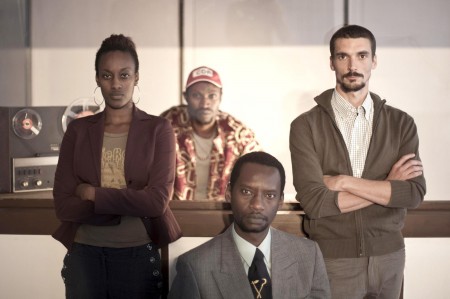Of the five Berlin-based productions invited to the Theatertreffen this year, Hate Radio is the only one I managed to see before the festival began. That’s how I came to be in the position where I can give you an idea of what’s to be expected at the show’s Theatertreffen premiere tonight.
Swiss director Milo Rau, founder of the International Institute of Political Murder theatre group and creator of IIPM projects such as The Last Days of Ceausescu, about the execution of the Romanian dictator, and The Dark Continent, a look at ethnic cleansing under Stalin, has most recently turned his attentions to yet another violent atrocity of the 20th Century. In his examination of the Rwandan genocide, it is the horrific and vicious anti-Tutsi propaganda proliferated by the Rwandan radio station RTLM that is placed under the microscope.
Bookended by statements from genocide victims and witnesses projected onto office blinds obscuring the set, Hate Radio presents a 60-minute RLTM show, transmitted to each audience member’s headset over a portable radio. With surgical precision, the layout of the RTLM studio is reconstructed in a glass cell, the audience seated on both sides. The actors are all genocide survivors, but they were also chosen for their resemblance to the original radio presenters, one of whom is still imprisoned in Rwanda. The script is made up of real RTLM transmission excerpts, performed in a mixture of French and Kinyarwanda. Costumes and props are historically accurate. And most realistically of all, nothing happens. Nothing but pure, shocking propaganda, interspersed with pop music, laughter, smoking, and drinking.

Afazali Dewaele, Sébastien Foucault, Estelle Marion, Nancy Nkusi, Diogène Ntarindwa. Photo: Daniel Seiffert
Even in a summary of the production, hopefully my own included, I think the issues that I struggled with are fairly easy to pick out: the claim of authenticity, the resulting lack of any “story” in the traditional sense, and the questions these two aspects raise regarding the definition of “theatre.” The IIPM’s own description of it doesn’t mention the word theatre, or even performance; the project is described as a “reenactment, exhibition, film, book.” Reviews and articles describe an “art experiment,” an “art project,” (Simone Schlindwein), a “theatrical work explained by Rau with recourse to art history” (Christoph Fellmann).
The performance of the work in Kiwali, Rwanda, didn’t take place in a theatre. The studio was visible from the street, and passers-by were handed headsets tuned into the “broadcast.” But in this case, it’s not the step out of the theatre and into the realm of performance art which is radical – Rau didn’t invent that – but its political implications. Schlindwein quotes concept developer Jens Dietrich explaining that what they are doing with this project “could have landed them in prison in Rwanda,” where the genocide is a taboo subject. The article goes on to give evidence that for the survivors of the crimes encouraged on a daily basis by RTLM presenters sitting in the comfort of their studio, Hate Radio was able to have a cathartic effect. For the generations who only learnt about the genocide in school, it makes a connection between the energy young people still invest in pop culture today, and the violent potential of that energy.
The majority of the German articles I’ve read about Hate Radio mention “Rape Me” by Nirvana in this context, one of RTLM’s favourite songs to blast out between weather reports, news items, and rallying for the rape and murder of Tutsis. The recurrence of this example can probably be put down to the strength of its connection to the western world’s experience of the 90s. It highlights the relevance of the material, seemingly very distant, to our own lives.
But relevance is not the problem. It’s clear from all of his work that what fascinates Rau is the human capacity for violence towards each other, and that’s something that is relevant all over the world, not least in Germany.
The problem is what happens when you trade the streets of Kiwali for Hebbel-am-Ufer in Berlin and present it as a piece of theatre – one of the 10 most remarkable pieces of theatre to be seen in the German-speaking world this year, as it turns out. Is Rau pushing the boundaries of what we call theatre? Or does a performance that had a radical, active, political impact on the street, reacting with the stories of the individual listeners to create a new story, a living piece of theatre, paradoxically become no more radical than an art installation being presented in a theatre instead of a gallery?
I honestly don’t know. I think maybe I need to see it again…